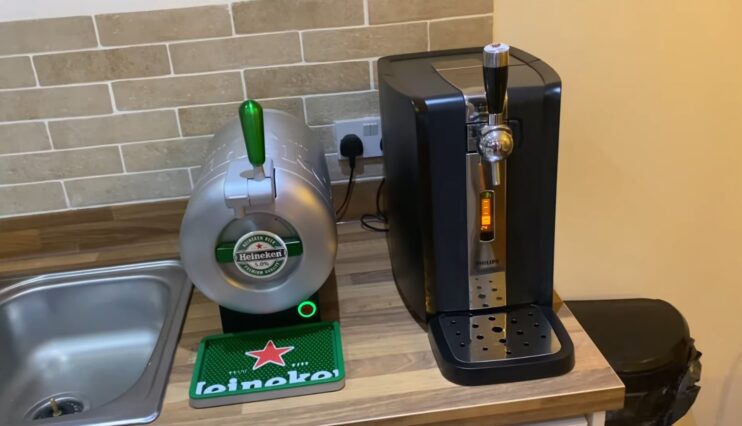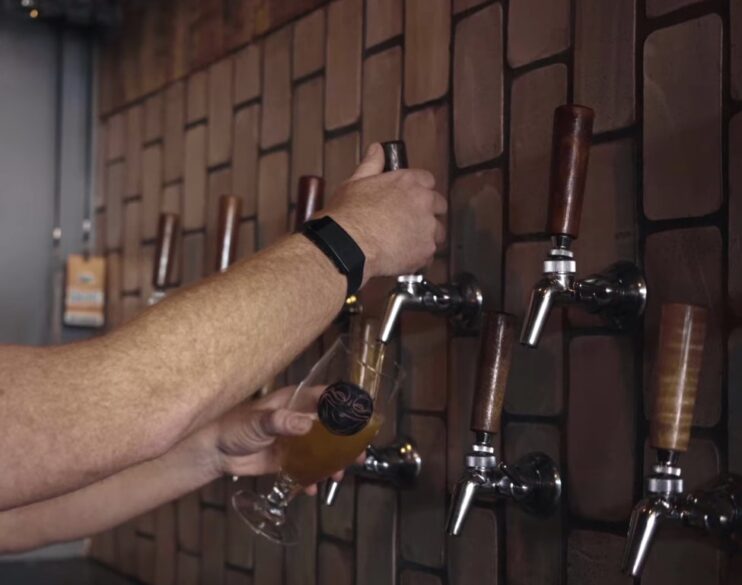Draft beer, also known as draught beer, is a beloved beverage enjoyed by many around the world. Its freshness and character are often highlighted as its defining features. But what exactly sets draft beer apart from its bottled and canned counterparts?
Draft refers to beer that is served from a cask or keg rather than from a bottle or can. This method of serving is traditional and is thought to preserve the original flavor and carbonation of the beer as intended by the Brewmeister.
How is it Made?
Draft is crafted through a meticulous brewing process that begins with the selection of ingredients. The four essential components are water, malted barley, hops, and yeast. Brewers combine these ingredients following specific recipes to create the desired style.
The mixture is then fermented, during which the yeast converts the sugars into alcohol and carbon dioxide, giving the beer its alcohol content and carbonation. Once the beer has matured, it’s transferred into kegs, a process that differs from bottling or canning. Kegs are designed to protect the beer from light and oxygen, both of which can adversely affect the flavor.
The keg is then connected to a draft system that uses pressurized gas to push the beer through lines directly to the tap, ensuring a fresh and flavorful pour.
There are Different Types
Draft model comes in a vast array of styles, each with its own unique profile, suited to different palates and occasions.
- Ales: Known for their fruity and complex flavors.
- Lagers: Appreciated for their crisp and refreshing taste. Along with the Pilsner, it is one of the most popular options today.
- Stouts and Porters: Loved for their dark, rich, and roasty qualities.
- Wheat Beers: Cherished for their light and slightly spicy notes.
Brewers often release seasonal drafts, taking advantage of different ingredients and flavors that correspond to the time of year. Craft breweries have also expanded the landscape of draft beer, introducing innovative and bold flavors, and often use local ingredients to add a unique touch to their brews.
What is the Best Draft Beer?

The title of “best” draft beer is subjective and often debated among enthusiasts. However, some brands have gained international recognition for their exceptional quality and taste. Below is a table showcasing some of the top-rated draft beers from around the world:
| Beer | Brewery | Country | Style |
|---|---|---|---|
| Pliny the Elder | Russian River Brewing Company | USA | Double IPA |
| Weihenstephaner Hefeweissbier | Bayerische Staatsbrauerei Weihenstephan | Germany | Wheat Beer |
| Guinness Draught | Guinness | Ireland | Stout |
While awards and expert opinions can guide us, the best draft beer is often the one that resonates personally with the drinker. Factors such as individual taste preferences, the setting, and even the company one keeps can influence this choice.
We have to mention that this beverage is among the biggest trends in recent years. There are many small breweries that are making a unique version. Therefore, the best way to determine the right flavor is to test what is offered in local pubs.
Why is it Better than Classic Bottles?

Those who prefer this beverage often cite the freshness and quality of the pour as superior to that of bottled one. It is not a surprise considering that a small brewery can add more effort and unique methods into the process, while large companies are more focused on quantity.
| Attribute | Draft Beer Advantages | Classic Bottled Beer Disadvantages |
|---|---|---|
| Exposure to Light and Air | Kept in dark kegs, minimizing exposure to light and air which can degrade taste. | Light can penetrate bottles, potentially leading to a ‘skunky’ flavor. |
| Freshness | Often consumed faster, ensuring a fresher taste. | Longer shelf life can result in a loss of optimal freshness over time. |
| Flavor and Aroma | Preserved as intended by the brewer, often more robust and complex. | Can be affected by the pasteurization process and storage conditions. |
| Carbonation | Carbonation is maintained at optimal levels from keg to glass. | Once opened, carbonation can quickly dissipate, affecting mouthfeel and taste. |
| Serving Temperature | Served at controlled temperatures to enhance flavor profiles. | Temperature can vary widely depending on storage, affecting taste. |
| Environmental Impact | Kegs are reusable, reducing packaging waste. | Bottles, although recyclable, can contribute to more packaging waste. |
| Variety and Rotation | Bars can easily rotate kegs to offer a wide variety of beer options. | Limited by bottle availability and shelf space, which can restrict variety. |
| Portion Control | Allows for different sizes of servings, from samplers to pints. | Typically restricted to the bottle’s volume, less flexible in serving size. |
| Quality Control | Tap systems are regularly cleaned, ensuring quality and taste are maintained. | Bottles can suffer from quality issues if not stored or handled properly. |
| Experience and Presentation | The ritual of pouring from a tap adds to the overall experience and enjoyment. | Lacks the interactive experience of draft beer; presentation is static. |
Why is Craft Beer so Popular?

Craft beer has surged in popularity over the past few decades, becoming a global phenomenon that has reshaped the beer industry. This rise can be attributed to several key factors that resonate with consumers’ evolving preferences and values.
Craft beer’s popularity is not just a trend; it’s a movement. It represents a shift towards artisanal, small-batch production where quality, flavor, and technique are paramount. This movement has encouraged a culture of beer appreciation akin to that of fine wine.
Focus on Quality and Flavor
Craft breweries prioritize quality and flavor above all else. They often use traditional methods and take creative liberties to develop complex flavor profiles. This dedication to craft and taste has won over consumers who seek more than just the standard lager.
- Innovative Brewing Techniques: Craft brewers are not afraid to experiment with brewing methods, often reviving old techniques or creating new ones.
- High-Quality Ingredients: There’s a strong emphasis on sourcing the best ingredients, such as premium hops, specialty malts, and unique additives like local fruits or spices.
Variety and Creativity
The diversity of craft beer is staggering. Unlike mass-produced bottles and cans, craft beers come in an array of styles and flavors, which has significantly broadened consumer choice.
- Seasonal and Limited Editions: Craft breweries often produce seasonal offerings or one-off batches, creating a sense of exclusivity and novelty.
- Collaborations and Community: Many craft brewers collaborate with each other, sharing techniques and creating community around their products.
Rising Community
Craft beer has fostered a strong community of enthusiasts. Breweries often serve as social hubs, and the act of sharing and discussing beer has built a culture that values connection and shared experience.
- Brewery Tours and Tastings: These events provide an immersive experience, educating consumers about the brewing process and the stories behind the beers.
- Beer Festivals and Events: Such gatherings celebrate the craft beer culture, bringing together brewers and fans from around the world.
Can you Make Homemade Craft Beer?
This is another very popular trend. The main advantage is that you can adjust the taste just for your preferences. Homebrewing allows you to experiment with flavors and styles, and while it requires some basic equipment and a bit of patience, the process can be quite enjoyable.
You will Need the Right Equipment
Here’s a list to get you started:
- Brewing Kettle: A large pot, usually stainless steel or enamel-coated, for boiling your ingredients.
- Fermenter: A container with an airlock where your beer will ferment. This can be a glass carboy or a food-grade plastic bucket.
- Sanitizer: Sanitation is crucial in brewing. You’ll need a no-rinse sanitizer to clean all your equipment.
- Siphon: For transferring beer from the fermenter to the bottling bucket, and from there into bottles.
- Bottles and Capper: You’ll need bottles and a capping tool to store your beer once it’s ready.
- Thermometer and Hydrometer: To measure temperature and specific gravity, respectively.
After you get all the essentials, the next step is to buy the necessary ingredients.
- Malted Grains: The source of the sugars that will ferment into alcohol.
- Hops: Flowers that add bitterness to balance the sweetness of the malt and can also add flavor and aroma.
- Yeast: The microorganism that ferments the sugars, producing alcohol and carbon dioxide.
- Water: This is the main component, water quality is important as it affects the final taste.
Also, the ability to make a high-quality beverage requires skills and experience. Here is a basic recipe:
| Step | Process | Description |
|---|---|---|
| 1. Mashing | Steeping Grains | Soak the malted grains in hot water to extract fermentable sugars. |
| 2. Boiling | Boiling Wort & Adding Hops | Boil the extracted liquid, known as wort, and add hops for bitterness, flavor, and aroma. |
| 3. Cooling | Chilling the Wort | Rapidly cool the wort down to a yeast-friendly temperature before fermentation. |
| 4. Fermenting | Yeast Addition & Fermentation | Transfer the cooled wort to a fermenter, pitch the yeast, and let it ferment for about two weeks. |
| 5. Bottling | Carbonation & Packaging | Transfer the fermented beverage into bottles with a small amount of sugar to allow for carbonation. |
FAQs
What’s the difference between draft and craft?
Draft refers to beer that is served from a keg or cask rather than from a bottle or can. Craft is a type of beer made by small-scale, independent breweries that emphasize quality, flavor, and traditional brewing methods. Craft beer can be served in bottles, cans, or on draft.
How do I know if a bar serves fresh draft beer?
To ensure you’re getting fresh draft pint, look for bars that clean their tap lines regularly, have a high turnover rate of kegs, and store their kegs at the correct temperature. Bars that offer a variety of draft beers and engage with local breweries are also more likely to serve fresh beer.
Why does draft beer sometimes taste better than the same beer in a bottle or can?
Draft beer often tastes better because it is typically fresher, having been stored in a keg that is less exposed to light and air, which can degrade the quality of beer. Additionally, the tap system allows for the beer to be served at the optimal temperature and carbonation level.
Can draft beer only be enjoyed at a bar or can I have it at home?
While draft beer is commonly associated with bars or pubs, you can enjoy it at home by investing in a home kegerator system. This appliance keeps kegs chilled and dispenses beer through a tap, allowing you to pour fresh draft beer in the comfort of your home.
Last Words
Draft beer offers a taste experience that is hard to replicate in bottled form. Its freshness, combined with the care taken in storage and serving, makes it a favorite among beer lovers. The experience will be even better if you choose a preferred craft beer as drafted.

